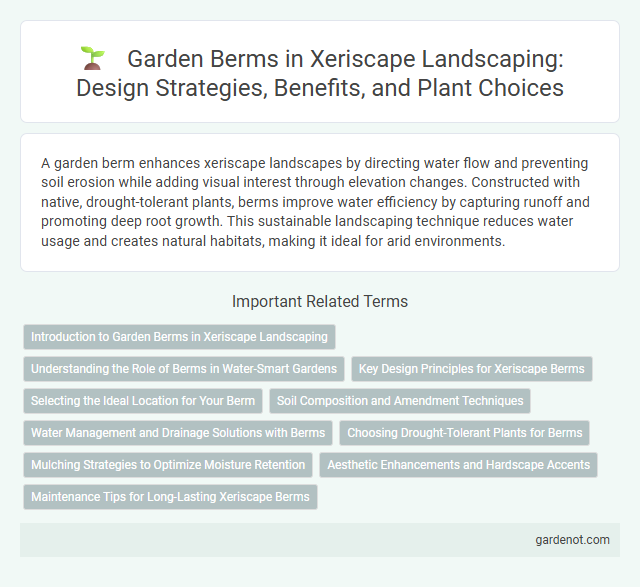A garden berm enhances xeriscape landscapes by directing water flow and preventing soil erosion while adding visual interest through elevation changes. Constructed with native, drought-tolerant plants, berms improve water efficiency by capturing runoff and promoting deep root growth. This sustainable landscaping technique reduces water usage and creates natural habitats, making it ideal for arid environments.
Introduction to Garden Berms in Xeriscape Landscaping
Garden berms in xeriscape landscaping enhance water conservation by redirecting runoff and improving soil drainage. These raised mounds are strategically positioned to protect drought-tolerant plants from erosion and maximize moisture retention. Incorporating native, drought-resistant vegetation on garden berms further reduces irrigation needs and supports sustainable landscaping.
Understanding the Role of Berms in Water-Smart Gardens
Garden berms in xeriscape gardening create raised, mounded areas that efficiently direct and retain water, minimizing runoff and promoting deep soil moisture. These earth formations enhance drainage while capturing rainfall and irrigation, encouraging healthy root growth for drought-tolerant plants. Incorporating berms strategically maximizes water conservation and supports sustainable, low-maintenance landscapes.
Key Design Principles for Xeriscape Berms
A Xeriscape garden berm utilizes elevation changes to enhance water runoff management and soil conservation, optimizing irrigation efficiency. Key design principles include selecting drought-tolerant plants appropriate for sloped environments, shaping the berm to direct water flow toward root zones, and using mulch or rock coverings to reduce evaporation. Properly constructed berms increase microclimates that support resilient vegetation, conserving water while maintaining aesthetic appeal in xeriscape landscapes.
Selecting the Ideal Location for Your Berm
Selecting the ideal location for your garden berm involves analyzing soil drainage, sun exposure, and existing plant placement to enhance water efficiency and aesthetics. Situate the berm where it can intercept runoff, improving irrigation management while complementing xeriscape principles. Elevating areas with natural contours also promotes healthy root systems and reduces erosion in drought-prone landscapes.
Soil Composition and Amendment Techniques
Garden berms in xeriscaping require well-draining soil with a balanced mix of sand, silt, and organic matter to promote water retention while preventing runoff. Incorporating compost and coarse sand improves soil aeration and nutrient availability, essential for drought-tolerant plants. Amendments such as biochar or gypsum enhance soil structure and moisture-holding capacity, optimizing plant growth in arid environments.
Water Management and Drainage Solutions with Berms
Garden berms serve as effective water management features by redirecting runoff and promoting infiltration in xeriscape landscapes. Constructed with layers of soil and organic matter, berms slow water flow, reducing erosion while enhancing drainage in arid environments. Their strategic placement helps retain moisture around drought-tolerant plants, optimizing water conservation in sustainable garden designs.
Choosing Drought-Tolerant Plants for Berms
Selecting drought-tolerant plants for garden berms enhances water efficiency and soil stabilization in xeriscaping. Native species like lavender, yucca, and ornamental grasses thrive in low-water conditions while adding texture and height to berms. Incorporating such plants reduces irrigation needs and supports sustainable landscape design in arid environments.
Mulching Strategies to Optimize Moisture Retention
Garden berms in xeriscape designs enhance water conservation by creating raised areas that direct runoff toward plant roots. Effective mulching strategies, such as using organic materials like wood chips or straw, improve moisture retention by reducing evaporation and insulating soil temperature. Applying a 2-3 inch layer of mulch around berm plants minimizes water loss and supports deep root growth, essential for drought-tolerant landscapes.
Aesthetic Enhancements and Hardscape Accents
Garden berms create dynamic elevation changes that enhance the visual appeal of xeriscape landscapes while improving water drainage. Incorporating hardscape accents such as natural stone, decorative boulders, or gravel paths along berm contours adds texture and structure, complementing drought-tolerant plant selections. These features increase garden depth and focus, making efficient use of limited water resources while highlighting native, low-water plants.
Maintenance Tips for Long-Lasting Xeriscape Berms
Regularly inspect xeriscape garden berms for erosion or compaction to maintain soil health and prevent plant stress. Utilize mulch layers to retain moisture and suppress weeds, reducing irrigation needs and promoting drought tolerance. Prune plants strategically to enhance airflow and prevent overgrowth, ensuring the berm remains aesthetically pleasing and functional over time.
Garden berm Infographic

 gardenot.com
gardenot.com